462 Corporal Albert Christopher Julius Graffunder C.C.
2nd Light Horse Regiment AIF
By Robert Simpson
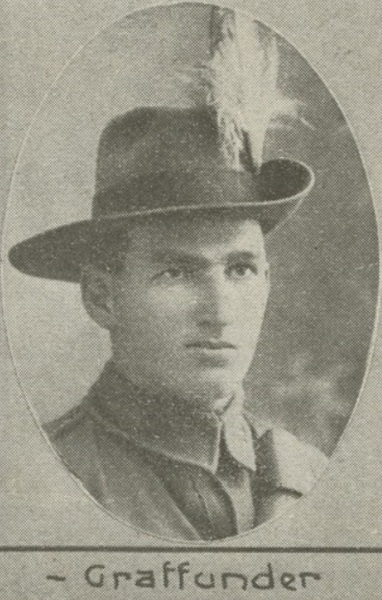
“Cpl. A.C.J. Graffunder , one of the soldiers photographed in The Queenslander Pictorial, supplement to The Queenslander, 1915.” It was on a page titled ‘Non-Commissioned Officers and Men of the Queensland A.L.H. FEGAN PHOTO’
Albert Christopher Julius Graffunder was born at Te Kowai near Mackay, Queensland on 21st July 1890. He was a son to Julius Christopher Albert Graffunder and Sylvia Ronilda Frances Beaton. Julius had been born in Petinyck, West Prussia about 1851 and was a 39-year-old labourer. It may have been the death of his father Karl in 1875 that caused the family to migrate to Brisbane in 1876, arriving there on 6 October from Hamburg on the Reichstag. His name was recorded as Julius Grawinder. He was naturalised in Queensland in 1879. Julius married Sylvia on 10 May 1883 in Mackay. Sylvia had been born in Mackay on 4 November 1865, with her parents coming from the United Kingdom and marrying in Mackay in 1864. Albert was one of five children to them. He was admitted to the Mackay Hospital on 21 November 1891. The Mackay Hospital Admissions has an entry on 25 March 1899 for Albert Graffunder, and another entry on 7 June 1908. In the Queensland Police Gazette Index of 1902, under Complainants, is an entry for an A C J Graffender. In the 1906 electoral roll, Julius was recorded as a labourer at Cattle Creek, near Mirani. By the 1915 roll, he was listed under Gruffunder at Boonah as a labourer. He passed away on 26 May 1920 in the Goodna Mental Institution, with his name recorded in death records as Julius Graffenden. He is buried in the Goodna Cemetery in an unmarked grave.
A newspaper report on 22 Oct 1888 reads ‘MAD WOMAN. On the 7th instant, says the Mackay Standard, a selector named Crawford residing at Ball’s Creek reported to the police that a woman who lived on the opposite side of the creek had gone mad, and was so violent that be had been obliged to leave his house and take refuge with a neighbour named Blakeley who lived several miles away. The woman is the wife of a selector named Graffunder who was working at Homebush, and she attacked Graffunder’s house with a tomahawk declaring she would have blood, and so terrified his family that they watched their opportunity, and, stealing away from the house, took a circuitous route for Blakeley’s. On receiving this intelligence, the Judge at once despatched Constable Fogarty, who, on arrival, found everything broken and thrown outside both houses and the woman gone, and neither she nor her three children aged three, four, and one year, were anywhere to be found. Constable Fogarty then went on to the Chase and here found the woman with the youngest of her children, the others however not being with her. It appears that the woman had come to the lower boundary of the Chase, and, throwing the child roughly on the ground, furiously attacked the fire with a stick which she carried in her hand, shouting out at the same time that she would kill the child as she had killed the other two. When the men at the camp tried to seize her she took up the child again by the dress and with its head hanging downwards, ran as hard as she could up the creek. Lavaring and a man named Wagner followed her, and after a long run secured her and conveyed both mother and child to Mr. A. Kemmis’s house. Here, the child was washed and attended to but the woman became so furious that she had to be tied up. On Constable Fogarty arriving on the scene the unfortunate woman was handed over to him, and he attempted to elicit from her some information as to what had become of the other two children, but could get no satisfaction. Eventually they were tracked by Mr. Kemmis’s black boy, who discovered them in the scrub about half way between the Chase and Graffunder’s house. The children were alive and well, and, with the exception of a few bruises, which they said their mother had inflicted with a stick, were unhurt. They were taken in charge by their grandmother, Mrs. Donald Beaton, and the unfortunate woman was conveyed to Eton in a buggy and from thence to town by train, and safely lodged in the lockup. She will probably be despatched in charge of a Constable to Woogaroo on the first opportunity.’
Another article in 1891 contains the following: ‘Sylvia Graffunder charged her husband, Julius Graffunder, with assault. Mr. Wright appeared for the defence. The plaintiff said that her husband had quarrelled with her on account of two men seen near the place. He had promised that her grave should be in Bell’s Creek that night, and that he would report to the police that she had drowned herself, whilst insane. He then administered a thrashing with some plough reins. In cross-examination she admitted that she had not always been virtuous but had reported her lapses to her husband. Mr. Wright pointed out the provocation which defendant had suffered, and the husband was eventually bound over to keep the peace for six months in his own recognisance of £30.’ Somewhere between 1895 and 1896, Sylvia must have left him and married (no record found?) James Harrison. She then had four children to him. In the 1905 electoral roll she was living at Millchester Creek in North Queensland and was doing domestic duties. She passed away on 14 September 1930 in Charters Towers and is buried in Charters Towers Monumental & Lawn Cemetery in LYND, Section 28, Plot 451, Grave # 7821, an unmarked grave.
Other children from her first marriage were:
– Donald Angus Graffunder was born on 28 June 1884 in Queensland. In the 1919 electoral roll, he was living at Bauple and was a labourer. An article in a Queensland newspaper dated Saturday 6 February 1926 reads ‘DONALD ANGUS GRAFFUNDER. of Bauple, In the State of Queensland, Farmer, was adjudged Insolvent on the First day of February, 1020. The First Meeting of Creditors will be held at the Principal Registry, Brisbane, on the Eighteenth day of February, 1926, at eleven o’clock in the forenoon.’ Another article on Tuesday 21 October 1930 read ‘Donald Graffunder, aged 47 years, fell down a well at Mirani, a distance of 30 feet, last evening. Fully 100 residents gathered about the well watching the ambulance bearers affect a rescue. After the lapse of over an hour Graffunder was brought to the surface, suffering from severe abrasions and concussion. He was taken to the District Hospital for treatment.’ He died on 27 May 1948 and is buried in Mackay City Cemetery.
– Olga Augustina Albert Graffunder was born on 24 January 1886 in Mackay. On 16 December 1908 she married Isaac Robert Gomersall (1886-1966) in Queensland. The local newspaper recorded the marriage as ‘A quiet but pretty wedding was celebrated at St. Paul’s Presbyterian Church yesterday afternoon, the contracting parties being Miss Olga Graffunder, eldest daughter of Mr. Julius Graffunder, of this town, and Robert Gomarsell (sic) of the Logan District. The bride was given away by Mr. O. Ungerer, and attended by her sister, Miss Sylvia Graffunder, as bridesmaid, while Mr. Albert Graffunder accompanied the bridegroom in the capacity of best man. After the ceremony a reception was held at the residence of Mr. O. Ungerer, where the happy couple received the congratulations of their many friends.’ The 1919 electoral roll shows them living at “The Palms” near Mackay, with Isaac a farmer and Olga doing home duties. She passed away on 15 March 1965 and is buried in Walkerston Cemetery Mackay in Presbyterian Section 1, Line 9, Plot 18 with her husband.
-Sylvia Ronilda Frances Victoria Graffunder was born on 16 September 1887 at Te Kowai, in Queensland. She married William Phillips (1883-1944) on 27 September 1911 at the English Church, Mackay. In the 1949 electoral roll she was living at 7 Pirie Street Mackay, doing home duties. She died on 23 April 1963 and is buried in Mackay City Cemetery with her husband.
-Vera Barbara Graffunder was born on 4 March 1895 in Queensland. She married William Morran (1883-1969) on 2 September 1933 in Queensland. She died on 28 December 1964 in Brisbane and is buried at Mount Bassett Cemetery, Mackay in C of E Section 1, Line 20, Plot 27, an unmarked grave.
Her children to James Harrison were:- Richard James Harrison was born on 29 November 1896 in Mackay. On 21 January 1916 he joined the 11th Reinforcements of the 26th Battalion as Private 4432 and gave his occupation as labourer. In France, while with A Company, 26th Battalion, he got influenza in June 1916 and then was wounded in action in August 1916. He was wounded in action again in March 1917 and after returning to his battalion was sent to hospital as being sick (ingrown toenails) in June 1917, after which he went AWOL for a day. For that he was awarded Field Punishment No 2 and forfeited pay. He was sent back to Australia ‘for family reasons’ on 27 August 1917, and was discharged in the 1st Military District on 9 November 1917.
On 26 January 1921 Richard married Isabella Hogg Laing Paterson. In WW2 he was with 16 Battalion Volunteer Defence Corps (QLD) as Q218236, enlisting on 11 August 1942 at Home Hill and being discharged as a Lieutenant. He died on 6 October 1973 at Home Hill and is buried in Home Hill General Cemetery. 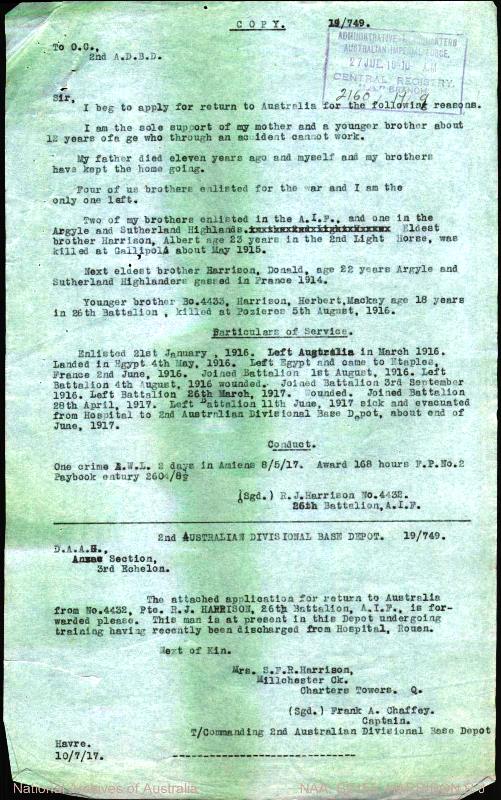
Copy of request to discharge for Richard Harrison
Herbert Mackay Harrison was born at Old Sawmill Paddock, Homebush via Mackay on 28 December 1898. He enlisted on 21 January 1916 with the 11th Reinforcements 26th Battalion as Private 4433. He was a labourer and had previous military experience with the RANR for 3 years, which he left as he left the district. Herbert was 5 foot 5¾ inches tall, weighed 8 stone, had a chest measurement of 30 to 33 inches, and had a dark complexion with brown eyes and curly brown hair. His religious denomination was Church of England. He landed at Etaples from Egypt on 9 June 1916 and proceeded to join his unit on 31 July. Herbert was killed in action in France on 5 August 1916. He is remembered at Villers Bretonneux Memorial MR 26, Part III G-J. His CWGC records reads ‘HARRISON, Pte. Herbert Mackay, 4433. 26th Bn. 5th Aug., 1916. Age 18. Son of Sylvia Ronilda Frances Beaton Harrison, of Tierney St., Queenton, Charters Towers, Queensland, and the late James Harrison.’ For his will, he left all his property and effects to his mother. Sylvia signed for his Victory medal, Memorial Plaque and Scroll in the early 1920’s. His British War Medal was sent to the Commandant in the 1st Military District on 9 December 1921, but there is no document to say she received it. His mother wrote some letters to Base Records in which she noted she had been ridiculed in Charters Towers and gave an account of some of her life and that four of her sons served. She noted ‘one of my sons was reported killed with liquid fire serving with the Argyleshire and Sunderland Highlanders (sic) Names of my sons age 31 Donald Angus Graffunder killed March 1915 France, 25 Albert Christopher Julius Graffunder May 1915 killed Gallipoli … age years 19 Richard James Harrison died of wounds and fever Lemnos Hospital, age 17.6 years Herbert Mackay Harrison killed 5 August France 1916’. She was sent his effects in 1918, which included a ‘Bible, photos, 2 Knives, Beads, Badge, Scissors’.
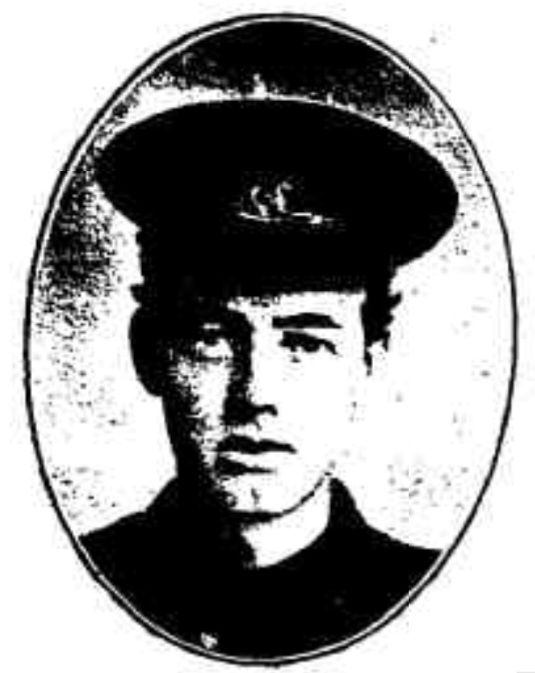
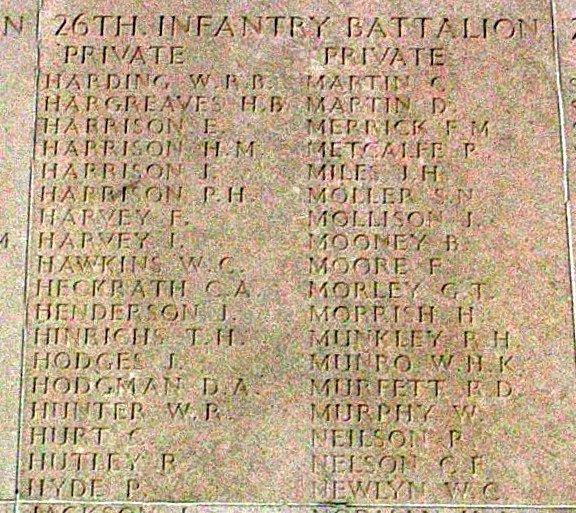 Percival Rupert Harrison was born on 18 January 1902 in Mackay. In the 1925 electoral roll he was living at Rita Island near Ayr and was a farmer. He enlisted in Rockhampton in WW2 on 9 June 1940 and was given the service number QX8255. Percival was with the 2/2 Australian Tank Attack Regiment attached to AAMC. He served in North Africa and New Guinea. After getting malaria in December 1943, he was sent back to Australia. After a few attacks of malaria he was sent to Morotai in late 1945 and then Balikpapan until sent back to Australia for discharge in November 1945. Percival died on 27 January 1978.
Percival Rupert Harrison was born on 18 January 1902 in Mackay. In the 1925 electoral roll he was living at Rita Island near Ayr and was a farmer. He enlisted in Rockhampton in WW2 on 9 June 1940 and was given the service number QX8255. Percival was with the 2/2 Australian Tank Attack Regiment attached to AAMC. He served in North Africa and New Guinea. After getting malaria in December 1943, he was sent back to Australia. After a few attacks of malaria he was sent to Morotai in late 1945 and then Balikpapan until sent back to Australia for discharge in November 1945. Percival died on 27 January 1978.
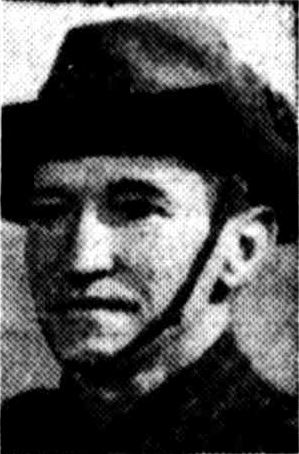
Euphemia Arabella Argyle Harrison was born on 12 July 1905 in Mackay but sadly passed away on 22 February 1906 and is buried in Charters Towers Monumental & Lawn Cemetery.
In the Daily Mercury of Mackay on Tuesday 20 February 1906 in page 2 was an article about an inquiry into a fire that destroyed the Greyhound Hotel in which ‘Albert Graffunder, stable-boy in the employ of Mr. Sleep, deposed that on Monday evening, the 12th inst, he drove Mr. Eagles to the Greyhound Hotel. They left town at half-past nine o’clock. At the Caledonian Hotel they pulled up for five minutes and went in and had a drink. They drove on, and arrived at the Greyhound Hotel at about half-past -ten. The only light about the place that witness noticed was a lamp hanging out-side. He did not see anyone on the hotel verandah. There were two or three persons lying on the hall verandah. Mr. Eagles appeared to be pretty well on in drink, but he appeared to have his senses about him. He got out of the sulky, and went on to the end verandah next to the town. He knocked at some door for a good while, when he came back and said to witness that he could not wake up any-body. Previously Mr. Eagles had told witness to wait for the 10/-. Witness waited for about 10 minutes altogether. Witness thought someone came out to Mr. Eagles, but he did not see anyone. Mr. Eagles said to witness, “I cannot wake anyone up I’ll see Sleep in the morning.” Witness then left.’
Albert Christopher Julius Graffunder was recorded in the 1912 electoral roll at Marian, near Mackay, and he was a farmer. In 1912 he had acquired a selection at Kolijo (near Calen) and had to clear the land for farming. The 1913 roll show him at the same place and occupation. The Daily Mercury of Mackay on Thursday 30 July 1914 in page 8 was an article titled ‘THE RIFLE’ which recorded ‘Following are the handicaps of the Farleigh Rifle Club for August 1st and 2nd, 1914; ranges 200 and 600 yards:— H. Windsor, A. Graffunder, 8:’ and a list of other handicaps followed. He was a member of the Marian Rifle Club. The same newspaper on 22 August 1914 in page 5 was a story ‘SEND OFF TO VOLUNTEERS. A fitting send-off will be tendered the local volunteers in the Star Theatre this evening, after the business houses close, at 9 o’clock. The Light Horse and Cadets have been called upon to parade at the Drill Shed at 8.45 and they will march with the departing soldiers to the Star Theatre. Members of the Mackay Rifle Club, the newly formed Town and District Guard, and the Citizens and Caledonian bands will also take part in the procession. A suitable programme has been arranged for and the volunteers will be extended the best wishes of what is expected will be a very large gathering. Following is a complete list of those who have been selected from Mackay to accompany, the expeditionary force:— , Light Horse: -W. Treermann, W. Henman, E. Illingworth, W. H. Adams; M. Murry, H. Mulherin, A. C. J. Graffunder, James Swinton, P. Hunter, R. McAleese. Infantry: D. R. Ward. J. Mudie, J. Farrell. W. J. Dewar, A. Gardiner, W. Lennon, W. Batchel, J. Dixon, H. G. Carthew, R. Graham. Capt. Graham; O.C. 27th Light Horse, has been asked to take charge of a squadron, and Lieut. G. S. Birkbeck (Mackay) has been offered the position of second in command.’ 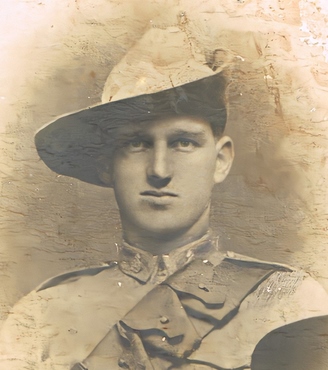
Photo of him in pre-WW1 Light Horse uniform.
On 26 August 1914, Albert attested with the Expeditionary Force in Gladstone. He stated his birth date and place and that he was a single British subject. His religion was Church of England. Albert had previous service with two and a half years with the 15th Australian Light Horse and 27th Light Horse. He now belonged with B Squadron, 27th Light Horse. Albert was a farmer by profession and lived at St Helens, Mackay. His next of kin was listed as his sister, Mrs Gomersall of the same address. For his medical certificate, he was listed as being 5 foot 7½ inches tall, weighed 11 stone 7 pounds, had a chest measurement of 36 to 37½ inches. His physical development was good, and he had a sallow complexion with greyish blue eyes and brown hair. Albert had no vaccination marks and a scar on his left thigh and a cut under his chin.
Albert was promoted to Lance Corporal on 29 August 1914 and then to Corporal on 4 September 1914. 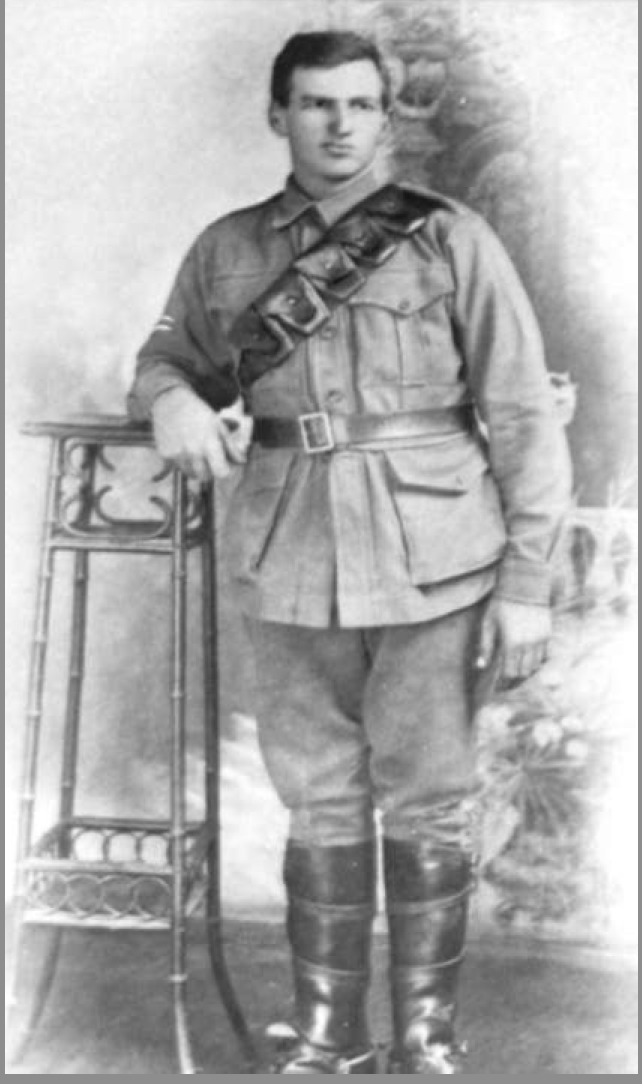
Photo of him with the rank of Corporal.
The Nominal Roll for 2nd Light Horse Regiment, C Squadron shows that 462 Corporal Albert Christopher Julius Graffunder was a 24-year-old farmer and single. His address at embarkation was Fairleigh, Mackay, Queensland; his next of kin was Mrs Gomersall of “The Palms” St Helens, Mackay. Albert joined on 21 August 1914, had been serving with the 27th Light Horse AMF on joining and recorded Church of England as his religion. He was paid 9 shillings a day before embarking and afterwards, 3 shillings to remain in Australia, 5 shilling 6 pence as net pay and 1 shilling 6 pence deferred pay. The battalion embarked on HMAT Star of England A15 at Brisbane on 24 September 1914.
In a newspaper in March 1915, an article included ‘Two of our lads represent us with stripes, namely Sergeant Tom Mulherin and Corp. Graffunder (known as get out and get under) they have proved themselves quite worthy of the positions they hold’.
In April 1915, the 2nd Light Horse Regiment was training in Egypt. At Heliopolis, four of their men died of measles and pneumonia during the month. On 8 May they entrained at Helmiah Railway Station at 1.20am and arrived at Alexandria at 6.30 the next morning, where they embarked on SS Devanha and sailed for the Dardanelles that evening. At 7am on 12 May, they disembarked at Kaba Tepe where they moved up to bivouac near Quinn’s Post. The next day at noon they relieved the 15th Battalion at Quinn’s Post. On 14 May they were relieved by the 15th Battalion, but C Squadron was left on post. C Squadron assaulted Quinn’s Post on 15 May with casualties recorded as ‘Major D Graham killed and 13 men killed, 11 men missing, 25 men wounded’. The war diary seems to be different to most other records on the date of his death. The History of the 2nd Light Horse Regiment, Australian Imperial Force, August 1914-April 1919 records that at ‘noon on May 13 we took over “Quinns” – “C” Squadron on the right …’ and ‘the enemy bombed us well all the afternoon.’ They had a number of casualties until they worked out to either smother or throw the bombs back. General Birdwood visited them on ‘the afternoon of the 14th’ and they were relieved. ‘Our “C” Squadron under major Graham, however, was detailed to remain on the post, to assault the enemy position during the night, to fill in the communication trenches, damage the enemy trenches and return before daylight.’ At 1.45am on 15 May the assault began, and the ‘assaulting parties had hardly mounted the parapet when they were met by showers of bombs and a tremendous volume of rifle fire’, and then the machine guns opened up. Only four men reached the enemy trench and then retired. Out of ‘60 men who made the sortie 25 were killed and 21 wounded.’
A letter published in the Daily Mercury of Tuesday 27 April 1915 in page 5 titled ‘LETTERS PROM THE FRONT. A SLANDER REFUTED.’ contains ‘Captain Birkbeck, 2nd L.H. Regt. A.I.E.F., writing from Heliopolis, under date March 15, states :— “Knowing the interest you took in the first volunteer force that left Mackay under myself for active service abroad, I feel sure will contradict the unjust and cruel statement that has been circulated in Mackay and district regarding one of its members, i.e., Albert Graffunder. This, I need hardly say, is an utter false-hood, without a vein of truth in it. In fact, Graffunder was made a Corporal a week after joining, and is Senior Corporal of my Squadron, and is looked upon by the whole regiment as one of the best Non-Commissioned Officers we have. There is not a mark against him, and he is the next for promotion to Sergeant. This, I think, speaks for itself as to the esteem in which he is held by his officers and comrades. Trusting you will give the above publicity and thus remove a slur cast upon one who is doing his duty for his King and country.’
A report of his death shows that 462 Corporal Albert Christopher Julius Graffunder of the 2nd Light Horse was killed in action at Monash Gully on Gallipoli on 14 May 1915. He had a will in his pay book. Albert was buried by Chaplain G Green at Pope’s Hill Cemetery on 15 May. It was 5/8 mile North-East of Anzac Cove. His will states ‘I hereby bequeath all my money coming to me from the Australian Imperial Forces to Mrs. W. Phillips, of Palms, Mackay, to Mrs. Robert Gomersall, of Palms, Mackay, North Queensland, Australia. The said money to be equally divided. I also appoint J.V. Brown, of Mackay, to administer same.’ His death was cabled on 29 May 1915. 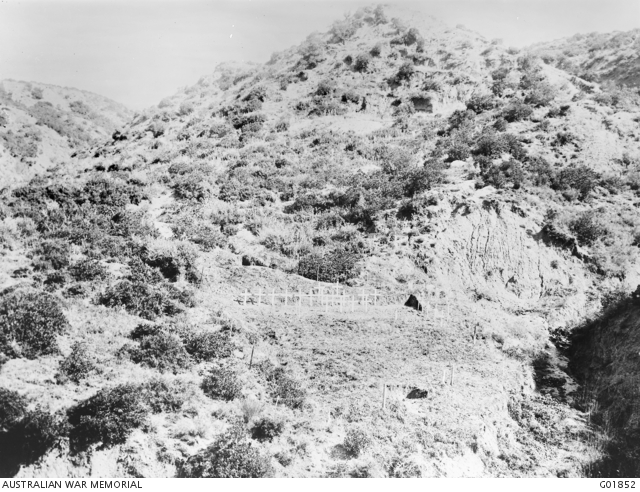 “Pope’s Hill Cemetery, taken from the side of a steep hill at the back of Courtney’s Post. Dead Man’s Ridge (which was held by the Turks) is on the right top corner, Pope’s Hill is in the centre, the lower spur getting out to the left was the extreme left of our position on Pope’s. The forward end of Russell’s Top is showing on the extreme left. The faint line showing in the col between Pope’s and Russell’s Top is a Turkish trench which they dug in July 1915 and which used to receive special attention from our destroyers. This trench is facing down Pope’s Reserve Gully. The steep side of the gully leading to the Bloody Angle and Quinn’s Post can be seen on the bottom of the picture. The sap showing at the back of the cemetery leads to the side of Pope’s where the steps carried on to the top. Ou trench line runs from the X on the extreme right to the X in the left centre. Most of the men buried in this cemetery are Australian 1st Light Horsemen and were killed on Popes. The crosses on the right hand side are all 2nd Australian Light Horsemen who were killed on Quinn’s Post on 14 May 1915. The white peg between the end crosses and the crosses at the back but slightly in front, marks the spot where five Turks were buried after they attacked us on 19 May 1915. This cemetery was in full view of the Turks on Dead Man’s Ridge and near Quinn’s Post. One of a series of photographs taken on the Gallipoli Peninsula under the direction of Captain C E W Bean of the Australian Historical Mission, during the months of February and March, 1919.” From AWM G01852
“Pope’s Hill Cemetery, taken from the side of a steep hill at the back of Courtney’s Post. Dead Man’s Ridge (which was held by the Turks) is on the right top corner, Pope’s Hill is in the centre, the lower spur getting out to the left was the extreme left of our position on Pope’s. The forward end of Russell’s Top is showing on the extreme left. The faint line showing in the col between Pope’s and Russell’s Top is a Turkish trench which they dug in July 1915 and which used to receive special attention from our destroyers. This trench is facing down Pope’s Reserve Gully. The steep side of the gully leading to the Bloody Angle and Quinn’s Post can be seen on the bottom of the picture. The sap showing at the back of the cemetery leads to the side of Pope’s where the steps carried on to the top. Ou trench line runs from the X on the extreme right to the X in the left centre. Most of the men buried in this cemetery are Australian 1st Light Horsemen and were killed on Popes. The crosses on the right hand side are all 2nd Australian Light Horsemen who were killed on Quinn’s Post on 14 May 1915. The white peg between the end crosses and the crosses at the back but slightly in front, marks the spot where five Turks were buried after they attacked us on 19 May 1915. This cemetery was in full view of the Turks on Dead Man’s Ridge and near Quinn’s Post. One of a series of photographs taken on the Gallipoli Peninsula under the direction of Captain C E W Bean of the Australian Historical Mission, during the months of February and March, 1919.” From AWM G01852
In the local newspaper on 5 June 1915 was a story under ‘PERSONAL. Mr. Jack Langdon, Sarina, left yesterday to enter the military camp at Enoggera. May the best of good fortune favour the young volunteer. The sorrow which the news of the death of Trooper J. Wentford occasioned in Mackay was manifested yesterday on all sides. From the flag poles of the various public and semi-public buildings, stores, wharves, shipping, hotels and other places in the town, flags were flown at half-mast — a tribute to the memory of the first Mackay native who has given his life to his country in the present clash of nations. It was a tribute that his sorrowing parents may well cherish with the memory of their son. The feeling of public sorrow was intensified when news came through of Corporal Graffunder’s death in action. Following quickly on the news of Trooper J. Wentford’s death came the sad intelligence that Corporal Alfred Graffunder had been killed in action. Corporal Graffunder was the youngest son of Mr. and Mrs. Julius Graffunder, of the Mackay district, and before his departure for the front was farming at Marian. He also was a native of the district, and about the same age as Trooper Wentford; in fact, the two were schoolmates at the local Boys’ State School, and were very popular amongst their school chums. Corporal Graffunder was a keen member of the local squadron of Light Horse and was amongst the first to enlist. So capable did he prove himself in training that he was quickly promoted to the position of Corporal. Quite recently Captain Birkbeck wrote to the “Mercury” in the terms of the highest praise of Corporal Graffunder’s attention to his duties since he left Mackay, and this good, opinion is borne out by other comrades in arms.’ Another entry that day about the Red Cross Society included ‘It was decided to send a letter of sympathy to the parents of ‘Private Wentford and Corporal Graffunder, the two Mackay natives who have already given their lives for their country.’
Another article in the Daily Mercury of Tuesday 15 June 1915 in page 3 read ‘Quite a gloom was cost over the young people of this district at the sad news of the death of yet another of Mackay’s heroes in action. I refer to the late J. Wentford, to whose sorrowing parents and kindred our deepest sympathy goes forth. Then again comes the news of the fall of Corporal Graffunder. whose untimely end we deplore. The Corporal was well known to this scribe as of sterling worth, and one of our most determined Australian soldiers. In the death of Albert his company has lost a marksman of no mean degree, as the following resume of some of his scores at Enoggera and Abassia will show, which was sent by him to his friend, Mr. Jack Thornton, to whose courtesy I am indebted for their publication as a fitting tribute to his memory: Corporal Graffunder’s musketry at Enoggera. — Grouping: 100 yards, 25 out of a possible 25; 200 yards, 18 out of a possible 20 ; 300 yards, rapid fire, 20 out of a possible 20; total 63, equal to 96.9 out of 100. Abassia Rifle Club, Cairo (grouping). —100 yards, 20 out of a possible 25; 200 yards (18 shots per minute), 18 out of a possible 20; 300 yards (18 shots per minute), 31 out of a possible 32; 500 yards, 10 but of a possible 20; total, 85 out of a possible 97, equal to 87.6 per cent. In a footnote to the above he writes: “In rapid firing I beat everyone here, 10 bulls out of 13 shots.” At 200 yards, 8 shots rapid fire (time, 1 min.), 7 bulls, one centre, 31 out of a possible 32 ; 200 yards, disappearing target (time five seconds exposure), 3 bulls, 2 centres, total, 18 out of a possible 20. Farleigh, 11th June, 1915.’
The Daily Mercury of Thursday 8 July 1915 in page 6 had the following letter ‘A GLORIOUS CHARGE. CAPTAIN BIRKBECK’S LETTER. News detailing how Corporal A. Graffunder and Private J. Wentford lost their lives at the Dardanelles, is graphically told in a letter received by Mrs. G. S. Birkbeck from her husband, Captain Birkbeck, whose own heroic conduct in leading the Mackay boys on a charge and in extricating them, though himself wounded, may be read between the lines. Captain Birkbeck writes from the hospital in Alexandra. He says :-”During the last fortnight things happened pretty rapidly, for me any way. We landed on Gallipoli on the 12th, went into trenches next day and I was back on hospital ship at ?(unreadable) a.m. on 15th with bullet in my right arm. As stated, we went into trenches, did twenty-four hours and then were relieved. On the same day I was informed that I had to lead an attack that night on some of the enemy’s trenches in our front and to hold them while another party came out and destroyed them. At half-past 1 a.m. we took up our position in our trench, myself and thirty men, and at a quarter past 2 crawled over the parapet and made a charge on the enemy’s trench. We cleared them out. Going over the parapet was hell, as the enemy kept up an incessant rifle fire and when we came over the top of our own trench they turned seven machine guns on us. I lost several men there, among them A. Graffunder. Well, we got through, and, as I said, cleared the enemy out and held the trench waiting for the others to come with picks and shovels. I saw them start but they had not the luck we experienced, and were mown down like grass before a mower. Then we destroyed as much of the trench as possible with our hands and bayonets, afterwards thought of retuning and found we were pretty well surrounded, but fought our way back to our own trenches. Of the Mackay boys with me the following casualties occurred — A. Graffunder, killed , Sergeant T Mulherin, wounded in the shoulder ; A. Howard, bomb exploded in the face , J. Wentford, bullet wound in the leg. (Private Wentford since died— Ed ‘DM’); and myself, a bullet in the arm. All the wounds are more or less slight, and all should be back in the firing line before many weeks. Poor Crabam led the second party and was killed before he reached us. Mulherin and I were wounded just after we got out of our trench, but as no bones were broken went on, in fact I did not take much notice of mine other than to feel if the arm was broken.’ The letter went on, mainly taking about himself.
Under the title ‘LETTERS OF SYMPATHY.’ in the Daily Mercury on Wednesday 8 September 1915 in page 4 it includes ‘He mentions that when wounded the first time Captain Birkbeck was sent to Alexandria, but on the second occasion he was sent to Heliopolis, where Dr. Kay is serving. The latter mentions Corporal Graffunder as having “done excellent work.” He adds, “The only consolation we have is that it is the great big lion heart and strong will of lads like yours that made the landing possible.”’
Base Records was sent a note on 25 October 1915 stating that Albert had been killed in action at Gallipoli, noted by ‘Cable No. M.F.C. 3396 from the Officer Commanding Intermediate Base, dated Alexandria 28th May, 1915 and confirmed by Army Form B 104 – 52.’
The Daily Mercury of Mackay on Monday 25 October 1915 in page 7 had an article titled ‘HOW CORPORAL GRAFFUNDER DIED. Speaking at the recruiting meeting at the Town Hall on Saturday evening Shoesmith Henman, who recently returned from Egypt, said he had heard rumours, since returning, about Corporal Graffunder being a spy, but he could tell them that was absolutely untrue and further, it took five bullets to kill him. He had the muscles of his arm blown away and was ordered by the Red Cross orderly to go back and have his arm dressed. He replied “No, I am good enough for a few of the —’s yet,” and as he turned round a machine gun got him and he fell with four bullets in the chest. “Major Graham, Corporal Graffunder and Arthur (Sarah) Anderson from Ayrlie buried side by side on the Gallipoli peninsula – three of the best, said the speaker; and there never was a more loyal man to serve his King and country than Corporal Graffunder, he was a soldier from start to finish, hard on the men under him at times — an officer had to be hard to make the men obey him — but never favouring one set of men more than another. He was an honest straightforward man and no one who had fought as he had done could be accused of being a spy. (Applause).’
A letter received from Captain Birkbeck was published in the local newspaper and noted ‘Next morning we were ordered into the trenches to take over from the 15th (Queenslanders) at Quinn’s Post, named after Hughie Quinn, of Townsville.’ It followed on with ‘Graffunder did splendid work here sniping, and so did others of the Mackay boys.’ Finally ‘It was just hell; the Turks turned seven machine guns on to us. Five men were killed going over, including Graffunder, and five or six more hit badly, including Mick Wentford.’ In November another story said ‘When I get back, if ever I hear a man say a word against Corporal Graffunder I will knock his teeth down his throat; a braver man never stepped. He was first shot through the head; but kept on; I hear the machine gun got him. He lies buried with Major Graham and “Sarah” Anderson at the foot of Quinn’s Post in the same grave, at the foot of the hill where they gave their noble lives.’
A letter was sent to Messrs. S B Wright & Wright Solicitors of Victoria Street Mackay from Base Records on 25 October 1915 supplying them with a ‘certificate of report of death of the late No. 462 Corporal Albert Christopher Julius Graffunder, 2nd Light Horse Regiment’. They were replying to a letter sent by the solicitor on 12 October and needed necessary proof of his death to obtain probate of his will.
Base Records replied to Mrs O A Gomersall of Palms Mackay on 29 October 1915, advising her that the personal effects of her brother would come by Thomas Cook and Son and would be forwarded to the next of kin noted in his service records, unless a will was available that stated otherwise. As for owing pay, ‘Mr. Wright should lodge a copy of the Will stated to be held by him, with the Military Paymaster, Brisbane.’ She had received the wire notifying her of his death and had written to Base Records on 19 October. In it she stated that he had made his will in favour of her and her sister. On 9 November 1915 SB Wright & Wright Solicitors thanked Base Records for sending a death certificate and asking if there was any money due to him and the amount.
On 18 November 1915 a letter from the solicitors was replied to by Base Records stating that the letter they sent had been sent to the District Paymaster, who would reply to them. The letter was sent by Base Records to the District Paymaster in Brisbane for their attention on the same day as well.
An inventory of his personal effects by the Camp Quartermaster showed there was 1 brown paper parcel which contained a pair of hair bushes and a leather case. Another brown paper parcel contained 3 pocket books and a purse. The two packets of personal effects were delivered by Thomas Cook and Son on consignment from Egypt on 14 February 1916 on SS Nestor to Mrs W Phillips, who signed for them on 28 March 1916.
The Daily Mercury on Wednesday 15 March 1916 in page 7 had a notice of ‘A SOLDIER’S ESTATE. Probate of the will of Albert Christopher Julius Graffunder, late of St. Helens, near Mackay, formerly farmer- but lately of His Majesty’s Imperial Forces, was last week granted to Eli. Beldon, of North Eton, near Mackay, farmer, the sole executor named in the will. (Messrs Roberts, Leu and Barnett, as town agents for Messrs. S. B. Wright and Wright, solicitors for executor). Personalty under £670.
Base Records sent a letter to Mrs Gomersall on 27 March 1916 stating they were ‘now in receipt of advice which shows that he was killed in action at Monash Gully, Gallipoli Peninsula, on 14th May 1915.’ 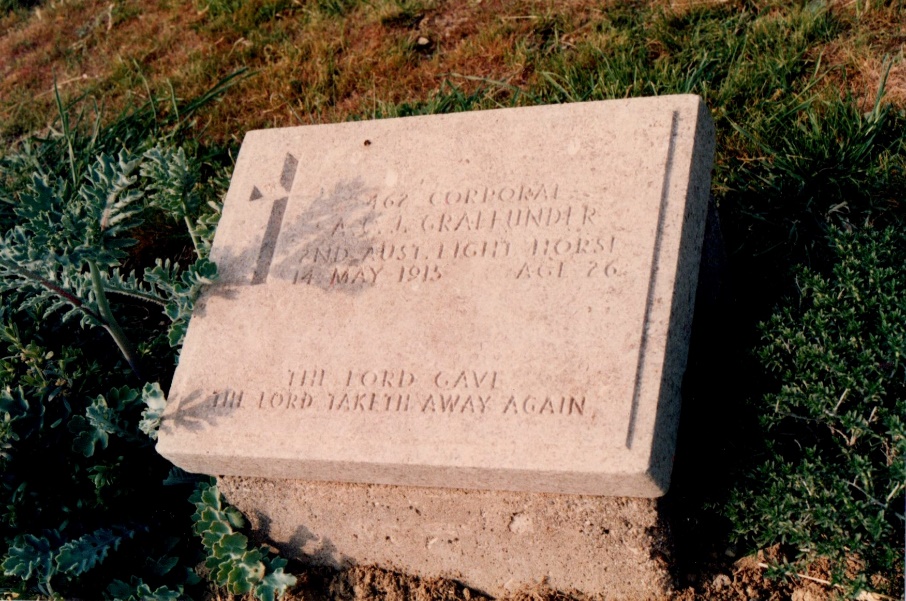
Grave pictures on Gallipoli.
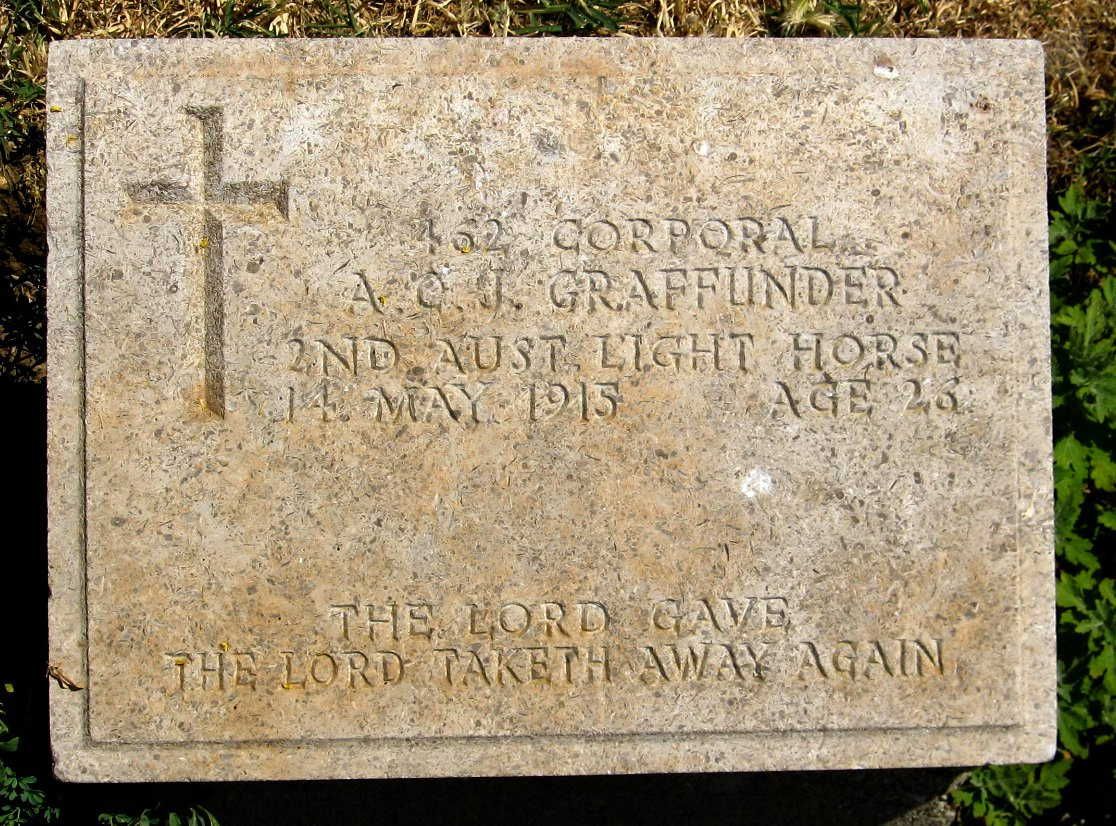
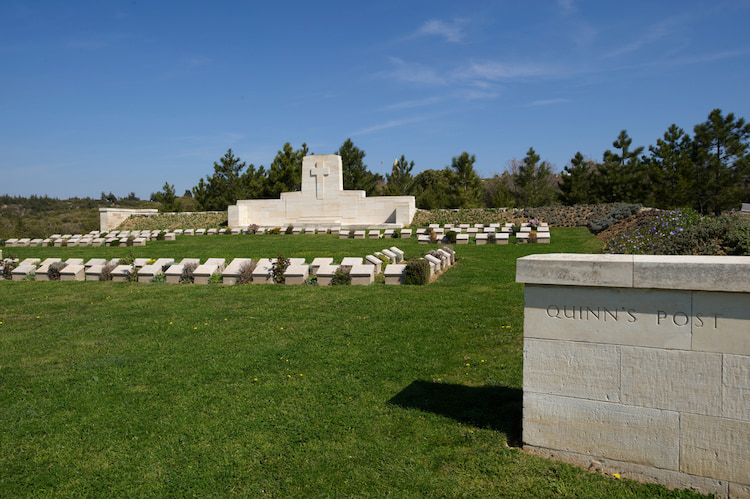
Quinn’s Post Cemetery (Image Credit: Shutterstock)
His grave is in Quinn’s Post Cemetery at plot D.2. His name is recorded in the CWGC on page 48 under Index No. GI.8 Quinn’s Post Cemetery ANZAC and reads ‘GRAFFUNDER, Cpl. Albert Christopher Julius, 462. 2nd Australian Light Horse. Killed in action 14th May, 1915. Son of Sylvia Ronilda Frances Harrison (formerly Graffunder), of Tierney St., Queenton, Charters Towers, Queensland, and the late Julius Christopher Albert Graffunder. Native of Mackay, Queensland. D. 2.’ A form from the Graves Registration Units has a list of men in Popes Hill Cemetery Anzac Gallipoli, 5/8 of a mile North East of Anzac Cove which includes 462 Corporal A C J Graffunder 2nd Light Horse Regiment with a date of 14.5.15. A Personal Inscription was added to the gravestone: ‘THE LORD GAVE THE LORD TAKETH AWAY AGAIN’. Another form of the list of graves at Pope’s Hill Plot, Quinn’s Post Cemetery lists Albert’s date of death as 15 May.
Albert is also recorded in the Queensland Death Indexes with registration number 003376 on page 762. His parents are listed as Julius Christooher (sic) Albert Graffunder and Sylvia Frances Victoria Beaton.
There is a file at NAA in Brisbane, titled ‘HARRISON, Sylvia Ronilda Frances beneficiary of GRAFFUNDER, Albert Julius Christopher – Service Number – 462’, which ranges from 1915 to 1930. It is open but not online.
Albert was recommended for a French Medaille Militiare with seven other members of the 2nd Light Horse Regiment on 15 November 1915 for ‘Gallantry in charge from Quinn’s Post’ and all were also ‘Mentioned in Army Corps Order No 183. Brigade Oder No 4 a 19/10/15’. A report in his service records from 1st Light Horse Brigade on 19 October 1915 that he was ‘Mentioned in despatches for valuable Services rendered between dates 6.5.15 & 26.5.15. Army Corps Order 183 Gallipoli Peninsula’.
A pension was claimed by his mother, Sylvia R F Harrison of Millchester Creek, Charters Towers. It was rejected as she was not ‘dependent on deceased member.’ Another document, this one dated 7 April 1916 showed the claim was granted ‘at £26 per annum from 2-11-15.’
Base Records sent Mrs Gomersall of Mackay a letter on 24 April 1917 adding to the previous letter ‘and buried at Pope’s Hill Cemetery, Gallipoli, on the 15th May, 1915. Chaplain G. Green officiating.’
The Daily Mercury of Mackay on Monday 14 May 1917 in page 2 under ‘IN MEMORIAM. GRAFFUNDER.— In loving memory of Corporal A. C. J. Graffunder, who was killed in action at Monash Gully, Gallipoli, 14th May, 1915. (Inserted by his loving sisters, Mrs. Armstrong and Mrs. Phillips.)’
On 29 May 1920 Base Records sent a letter to Mrs SRF Harrison in Charters Towers, asking her if Albert’s father was still alive, and his name and address, ‘so that the late soldier’s military affairs may be finalized.’
Base Records was sent a note from AMF Headquarters 1st Military District on 6 October 1920 with a letter from W T Mitchell MA Solicitor of Charters Towers.
On 15 September 1920 Base Records sent a letter to Headquarters in the 1st Military District stating that “On 29th May last, a communication was forwarded to Mrs. S.R.F. Harrison, at Millchester Creek, Charters Towers, Q., requesting her to let me know whether the father of the late No. 462, Corporal A.C.J. Graffunder, 2nd Light Horse Regiment, was still alive, and if so, to furnish his name and address. As no reply has so far been received I shall be obliged if you will endeavour to obtain the information required and advise me as soon as possible, as it is desired to dispose of the 1914/15 Star and other War Medals, etc., issuable on account of the abovementioned late soldier’s service.’
W T Mitchell, Solicitor of Charters Towers wrote to Military Headquarters in Brisbane about a letter they had sent Mrs S R F Harrison. He records that she ‘is the soldier’s mother, his father being dead.’ He enclosed a copy of Albert’s birth certificate and made a claim to Albert’s ‘war medals and decorations’.
Base Records received a receipt back on 6 September 1921, a receipt of photos of the grave of Albert that Sylvia Ronilda Frances Harrison had signed for on 27 August 1921. In his service file are a few envelopes that have been returned to Base Records due to incorrect addresses. Sylvia signed for his Victory Medal on 27 June 1922. It was noted that his Memorial Scroll was amended on 21 July 1922 to read ‘Cpl ACJ Graffunder 2 LHR AIF’. She signed for his Memorial Scroll on 8 August 1922. There was an issue on 2 August 1922, with his Memorial Plaque with the surname incorrectly embossed as Grallunder. Sylvia signed for it on 29 January 1923. A letter sent to Sylvia on 17 April 1925 let her know that the remains of 462 Corporal ACJ Graffunder had been exhumed and re-interred in Quinn’s Post Cemetery, Anzac, about ¾ mile North-East of Anzac Cove, with reference as Popes Hill Plot, Row D, Grave 2. A letter from Base Records to her on 28 January 1927 they said they would send her a copy of the register of Quinn’s Post Cemetery in a few days and included her receipt. They also acknowledged an error in the age of Albert, which they could not amend as ‘printed copies had already been prepared for publication.’ His details and death were also recorded on a Nominal Roll.
She also filled out the Roll of Honour for the War Museum, recording ‘ Albert Christopher Julius Graffunder, 462, ‘2nd Australian Light Horse Regiment 26th Battalion’, was connected with the town of Mackay in the Howard District of Queensland. He died on 14 May 1915 at ‘Gallopli (sic) Dardanells (sic) Egypt.’ Albert was a farmer, age 26, State School Mackay was his school and he had other training with the ‘Volinteer (sic) Kennedy Regiment’. She stated her full name and address as ‘Tierney street Queenton Charters Towers’ and for a reference put ‘Police Magistrate Court House Wood Street Mackay’.
‘The Last Post Ceremony is presented in the Commemorative area of the Australian War Memorial each day. The ceremony commemorates more than 102,000 Australians who have given their lives in war and other operations and whose names are recorded on the Roll of Honour. At each ceremony the story behind one of the names on the Roll of Honour is told. Hosted by Charis May, the story for this day was on (462) Corporal Albert Christopher Julius Graffunder, 2nd Australian Light Horse Regiment, First World War.’ From AWM – https://www.awm.gov.au/collection/C2124598, his story was read out on 12 October 1915. Albert Christopher Julius Graffunder’s name is located at panel 3 in the Commemorative Area at the Australian War Memorial. His name will be projected onto the exterior of the Hall of Memory on: Thursday 18 January 2024 at 4:59am and Friday 10 May 2024 at 7:29pm.
Various streets in Mackay were named In honour of fallen Mackay soldiers. Graffunder Street is in South Mackay as is about 800m in length. 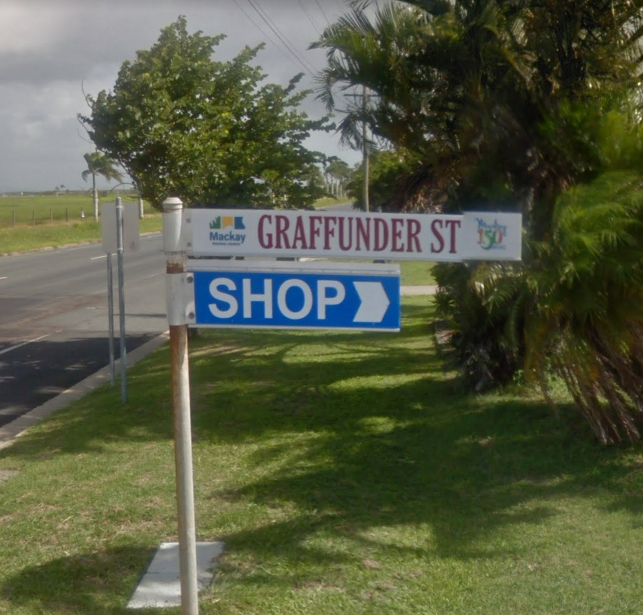
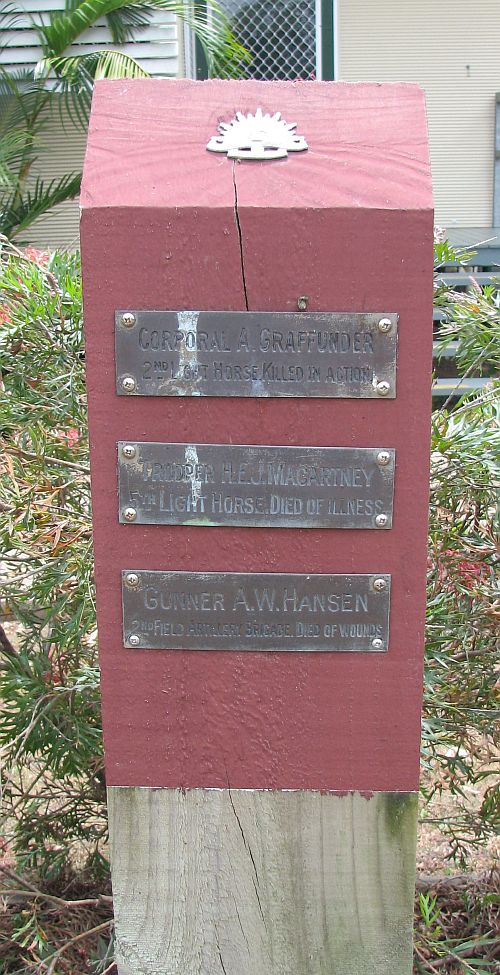 This is in the Remembrance Garden at Hampden State Primary School, Bruce Highway, via Kuttabul (picture from Glen Hall Collection, October 2006)
This is in the Remembrance Garden at Hampden State Primary School, Bruce Highway, via Kuttabul (picture from Glen Hall Collection, October 2006) 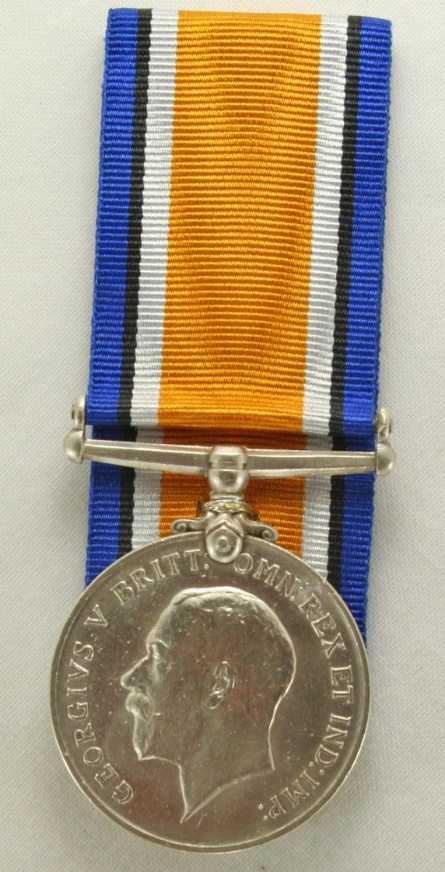
The Maryborough Military and Colonial Museum only has his British War Medal.
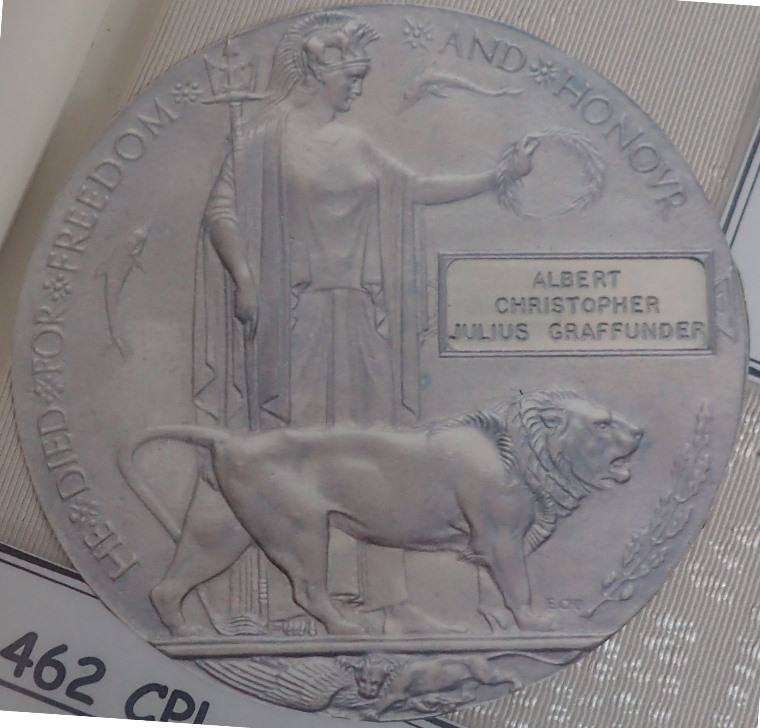
Photo of his Memorial Plaque in the museum display.
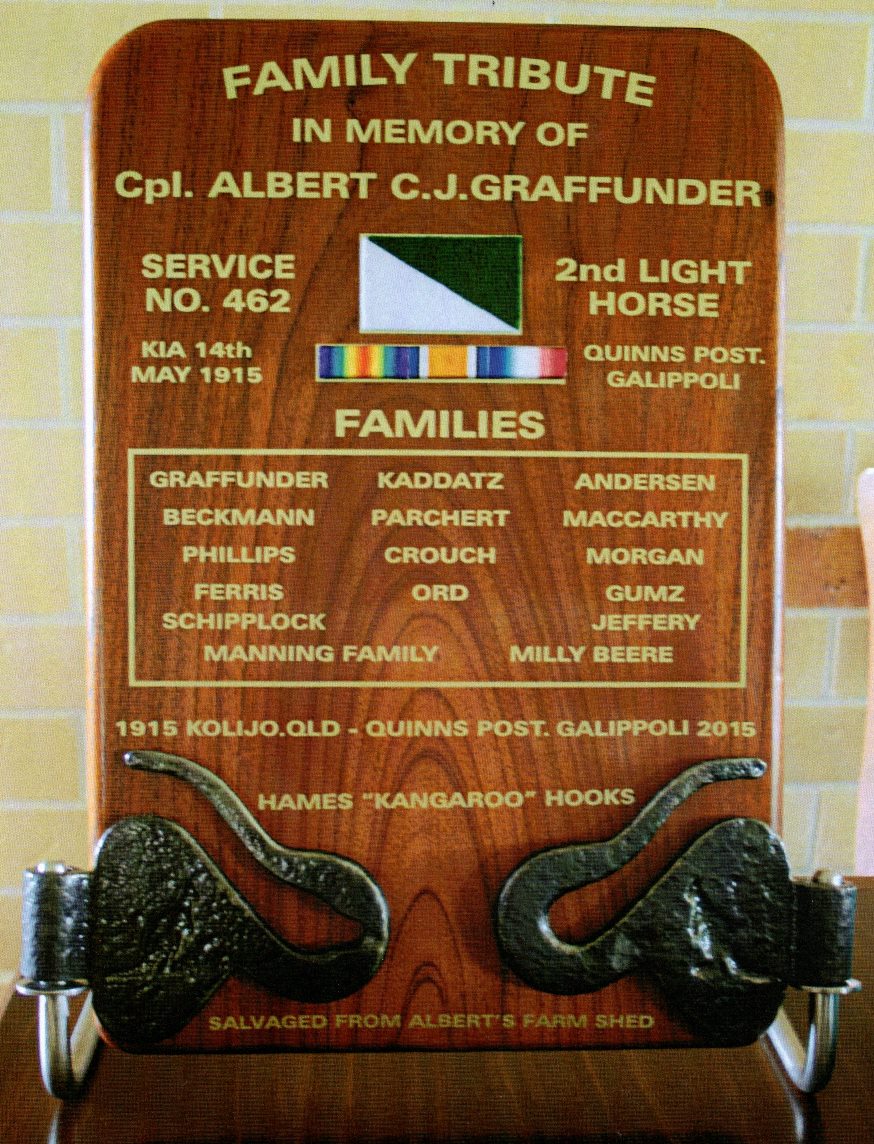
Family Memorial. A nephew had visited his ‘former farm at Kolijo, from where a pair of Hames Hooks, known to be part of Albert’s draught hose equipment and salvaged from the original farm shed long since flattened by a cyclone, were presented by the family who purchased the farm from Albert’s estate. These hooks were used to mount a family tribute plaque, presented to the Hampden State School Museum at Kuttabal’.
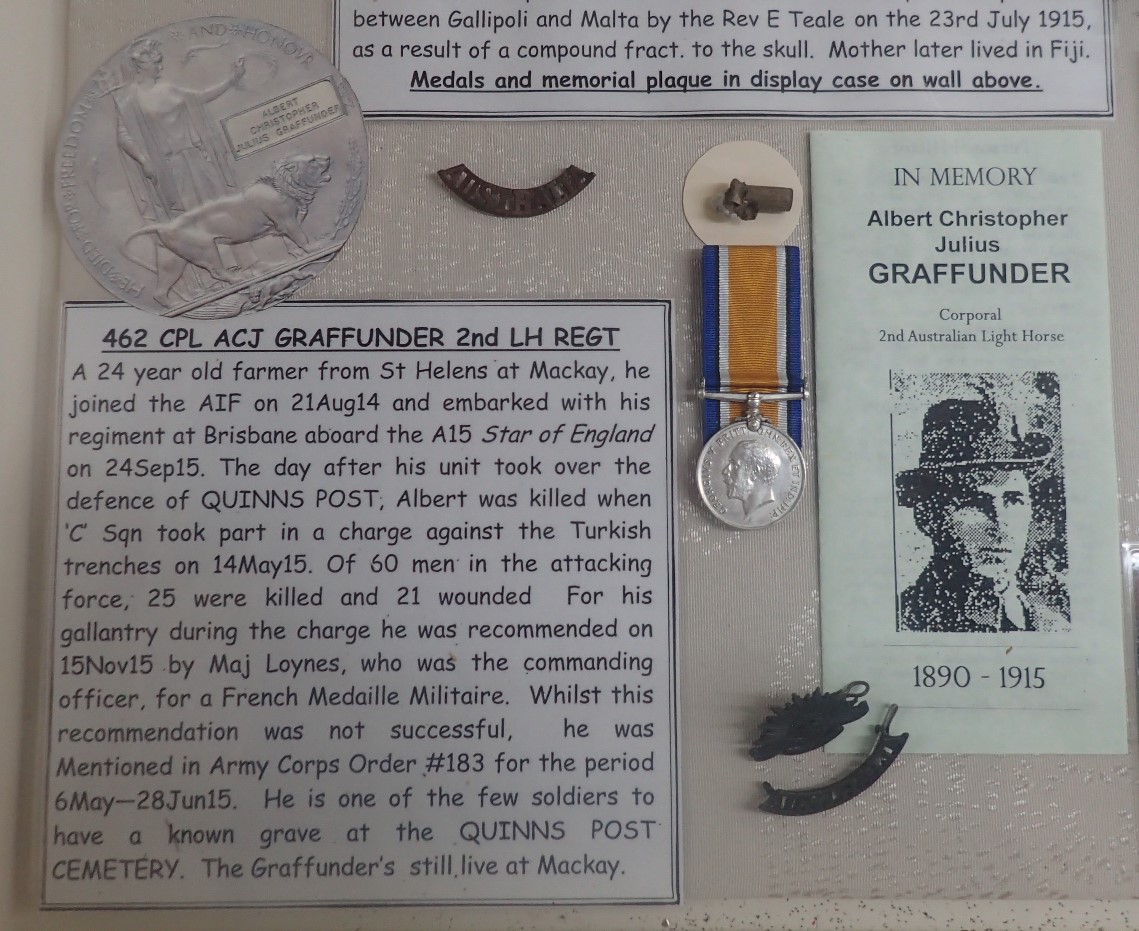
His display in the Gallipoli Room at the museum.
ANZAC Biographies
On our website you will find the biographical details of ANZAC (as well as British) servicemen & women whose medals or other memorabilia form part of the collection on display at the Maryborough Military & Colonial Museum, Maryborough, Queensland, Australia.